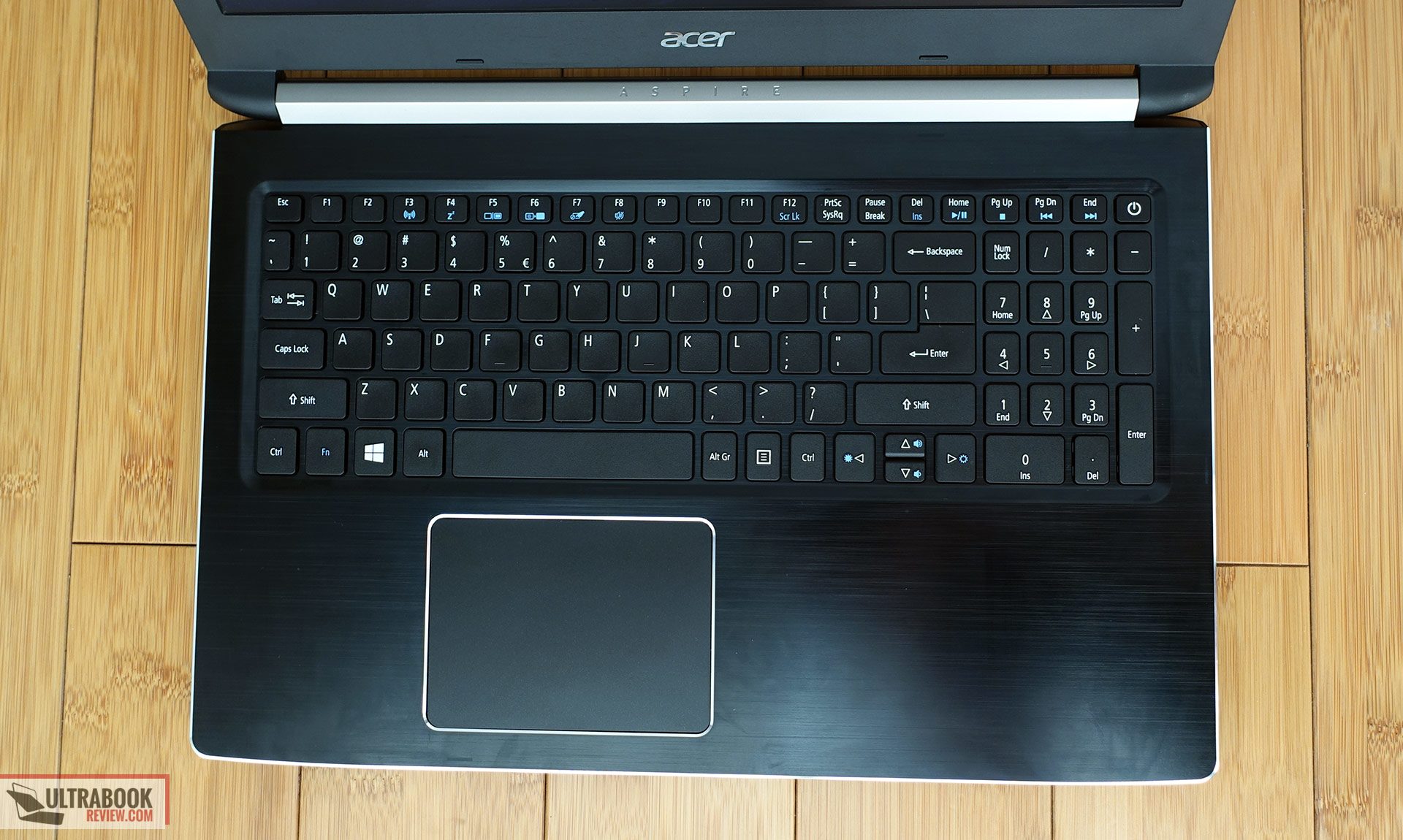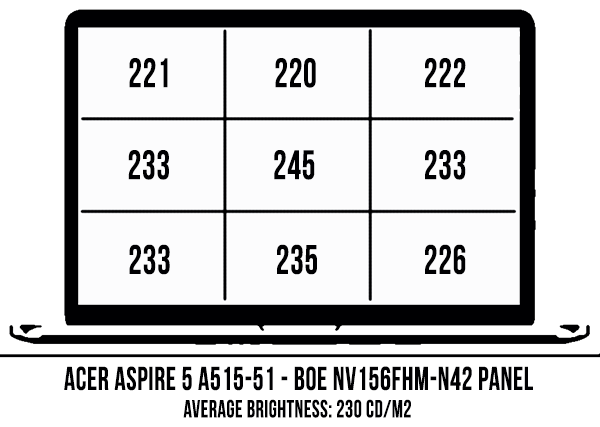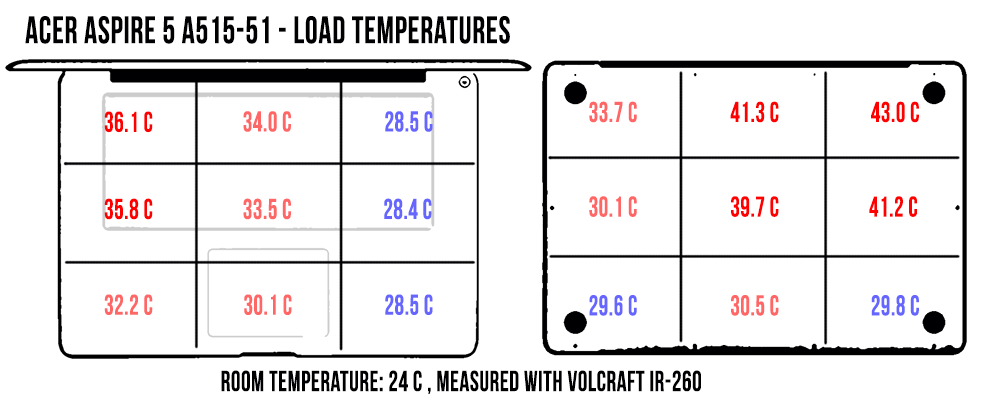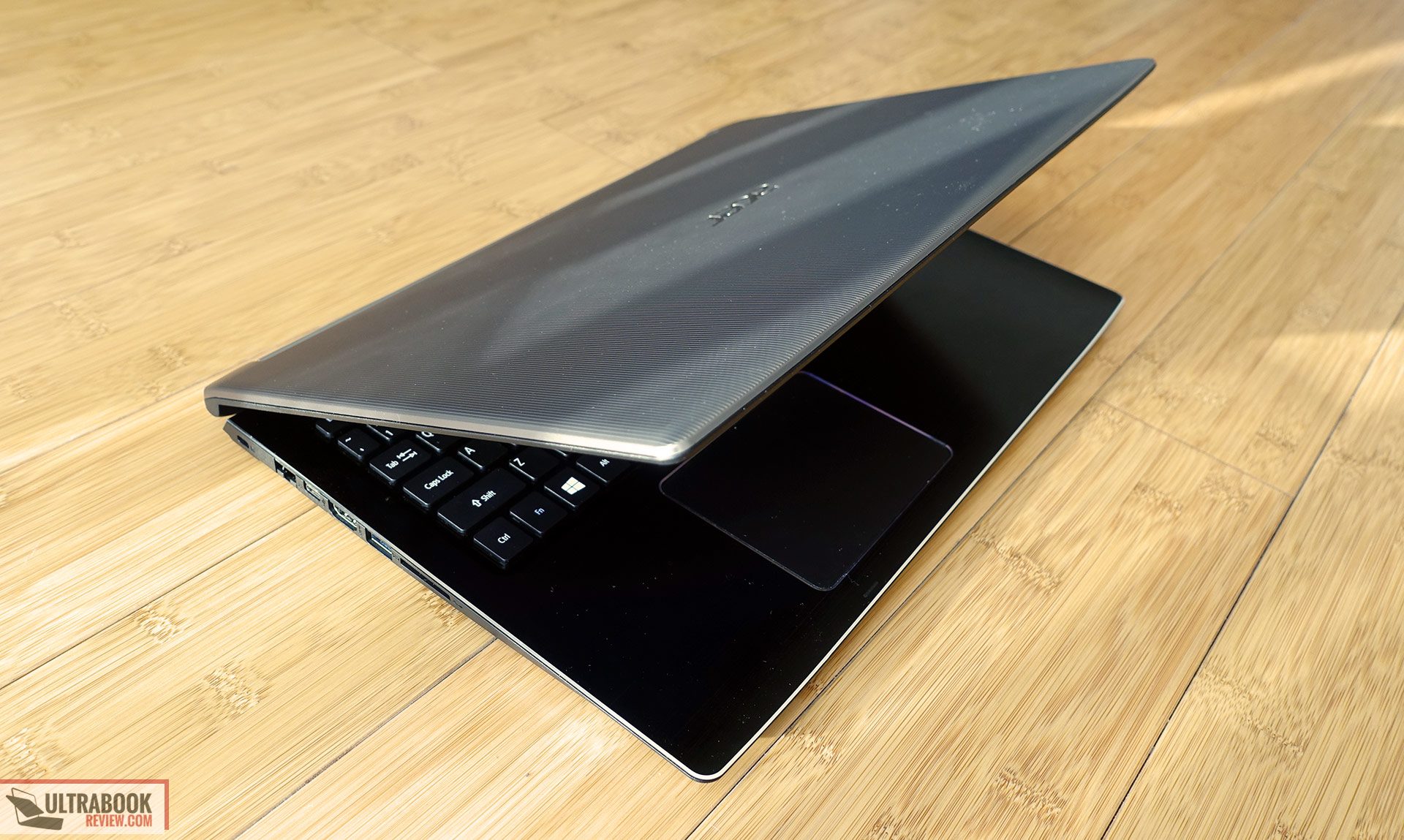Acer Aspire 5 A515-51 review – an excellent and affordable mid-range 15-inch laptop
While this has somewhat changed recently, Acer laptops have been historically known for their affordable price tags and overall solid value for the money, albeit with a few cut corners here and there, perfectly normal for budget laptops.
This article is about one such device, the Aspire 5 A515-51 series that Acer released around mid-2017 and from what I can tell, is an update of their popular Aspire E15-575 series.
That means the Aspire 5 is a 15-inch laptop that sells for between $400 and $600, runs on Intel Core U hardware platforms and offers good-enough screens, keyboards, IO and battery life. As for those cut corners aforementioned, I can list the lack of a backlit keyboard, a mostly plastic construction, and a rather slow Wi-fi connection, but none are actually deal-breakers in this price class if you ask me.
We got to test the higher-end model of the Aspire 5 A515-51 in the last few weeks, with a Core i7 CPU, matte IPS screen and hybrid storage, and we’ll tell you all about it in the article below.
Mục Lục
Specs as reviewed
Acer Aspire 5 A515-51
Screen
15.6 inch, 1920 x 1080 px, IPS, non-touch, matte
Processor
Intel Kaby Lake Core i7-7500U CPU
Video
Intel HD 620 (Nvidia MX150 available on some models)
Memory
20 GB DDR4 (4 GB soldered, one DIMMs, up to 20 GB)
Storage
256 GB SSD (M.2 SATA) + 1 TB 5400 rpm HDD (2.5″)
Connectivity
Gigabit LAN, Intel AC 3168 Wireless AC , Bluetooth 4.1
Ports
1x USB 3.0, 2x USB 2.0, 1x USB 3.1 gen 1, HDMI, mic/earphone, SD card reader, LAN, Kensington Lock
Battery
48 Wh, 90 Wh charger
Operating system
Windows 10
Size
383 mm or 15.07” (w) x 264 mm or 10.39” (d) x 22 mm or 0.86” (h)
Weight
4.62 lbs (2.1 kg)
Extras
non-backlit keyboard, webcam, stereo speakers
The Aspire 5 is available in a multitude of configurations, with KabyLake dual-core and quad-core processors, as well as with or without dedicated graphics. You should follow this link for updated configurations and prices, as well as this link for more details on what the Nvidia MX150 configuration is capable of.
Update: A detailed review of the more recent Acer Aspire 5 AN515-57 series is also available on the site.
Design and first look
Both design and build wise this Aspire 5 is a step-up from the Aspire E15 series.
For starters, it’s thinner and lighter, weighing in about 4.6 lbs with a HDD and SSD included, while the older models weigh around 5.3 lbs. Second, while the construction is still mostly plastic, the interior (palm-rest and area around the keyboard) is made from a sheet of aluminum with beveled edge, which feels more premium when touched or looked at. Third, thanks to the drop in height this notebook is also a lot sturdier. There’s very little flex or give in the main body, the keyboard deck and even the hood. In fact, I can say this laptop is better built than the Aspire 7 we tested a while ago and most other mid-range computers we’ve seen in a while, including those with fully-metallic constructions.
There is however something I have to add about that metallic interior. It’s black, at least on our version, which means it shows smudges and fingerprints easily, like you can expect from such dark brushed aluminum surfaces. On top of that, the machine cut edges are very sharp and although the front-lip has a lower profile than the Aspire 7, those of you with larger hands will still find out the hard-way that they can bite into your wrists or forearms when using the laptop on a desk. This might not sound like a big deal, but it is and I’d recommend checking it out yourself in a store if possible. You’ve been warned!
That aside though, there’s very little I can complain of. The lid has a nice texture and comes in gray on our version, which hides smudges well, there are absolutely no lights inside, as even the status LEDs are discrete and placed on the side, the bottom is made from solid hard plastic and the hinges work smoothly all the time. They might seem small, but actually keep the screen well in place and allow users to actually lift it with a single hand, as well as flip it all the way flat to 180 degrees. This laptop also sits nicely on a desk, thanks to the large and grippy rubber feet on the belly.
Speaking of that, down here you’ll also notice some large air intake cuts that allow peaking at the cooling inside, as well as the speakers and two bays for easy access to the RAM and the 2.5″ storage bay. Hot air goes out through the back, just as it should.
As far as IO goes, all the ports are lined on the right and left edges. Even the arrangement is pretty good, with the PSU, two USB Type A 2.0 slots and the audio jack on the left, while all the others are on the right: Kensington Lock, LAN, HDMI, USB 3.0 Type A and USB 3.1 Type C gen 1, as well as the card-reader. In other words, if you plan to use this with a mouse you’ll have plenty of space to maneuver it on the right side. Tough luck if you’re a lefty, but you guys have more options anyway, as most OEMs actually put the IO on the right.
Keyboard and trackpad
The keyboard hasn’t suffered any changes from the ones on the Aspire E15 lines as far as I can tell, so you’ll find plenty of opinions about it online and you should also be able to give it a test in stores on those models.
That means it gets a decent layout, with 15 x 15 mm main keys, but a narrower NumPad section, half-size Up and Down arrow keys, as well as the Power button integrated as the top-right key.

After typing a few thousands words on it I can say it’s not bad. The stroke is pretty short and the response perhaps a little shallow, but this keyboard actually felt somewhat more accurate than the one on the Aspire 7, which might seem identical, but in my opinion is not. In other words, I’m confident most of you will find this keyboard good enough for daily use.
What you should keep in mind is that the keys are not backlit, which I’d say it’s pretty normal for the class, albeit there are some exceptions out there. With the Aspires you’ll have to step up to the 7 series to get illuminated keys, albeit that’s also built on a different hardware platform. I can’t tell whether Acer has a new line with Core U hardware and backlit keys, some sort of a follow up for the Aspire F15 F5-573G model, but I’d reckon they’ll have one at some point in the near future.
The trackpad sits beneath the keyboard, centered on the Space key. It’s a large plastic surface made by Synaptics, without dedicated drivers on this test unit, but I didn’t feel the need to tweak anything, as this trackpad actually works very well out of the box.
In fact I can say it’s one of the better trackpads I’ve seen on a Windows laptop in a while, regardless of price. I don’t have anything to complain about its speed and response, whether it comes to swipes, taps or gestures, with or without a finger on the click areas. The click buttons are also fairly smooth and quiet, and even if this is made out of plastic, it’s rigid enough so its doesn’t sound hollow when taped firmer, like with most other plastic trackpads.
If you’ve read some of my other reviews you know I’m usually harsh on trackpads, but this one somehow managed to sweep me of my feet.
Screen
There will be two screen options available for the Aspire 5 series from what I can tell so far, a 1366 x 768 px TN panel and a 1920 x 1080 px IPS panel. We got to test the latter, and although I haven’t’ seen the HD option in action, the fact that it’s a TN panel is enough to tell you to stay away from it. Albeit the FHD option is more expensive, it is worth every penny. On the other hand, you’ll probably not find the IPS panel on the entry level Core i3 configurations, so if you’re aiming at the $400 variants of this laptop you’ll just have to accept the TN screen. But be aware it’s crap by today’s standards.
The FHD IPS panel isn’t the best IPS option you could find on a 15-inch laptop for sure, but it’s good enough for a budget laptop, with up to 250 nits of brightness, great contrast and good viewing angles, but rather lacking in terms of color coverage. Blues, greens and especially reds are off by quite a few orders of magnitude, but with the help of our calibrated profile you’ll get them to look at least decent for everyday use. More details below.
- Panel HardwareID: BOE BOE06c6 (NV156FHM-N42);
- Coverage: 67% sRGB, 49% NTSC, 51% AdobeRGB;
- Measured gamma: 2.3;
- Max brightness in the middle of the screen: 245 cd/m2 on power;
- Contrast at max brightness: 760:1;
- White point: 7100 K;
- Black on max brightness: 0.32 cd/m2;
- Average DeltaE: 1.49 uncalibrated, 0.98 calibrated.


I will also add here that I noticed some light bleeding on our test unit, with the bezel pinching the screen in several points on the top and bottom edges, but that’s not uncommon with budget notebooks with matte screens. Whether you’ll end up with a unit with little or severe bleeding is unfortunately just a matter of luck these days, so my advice is to always buy from places that accept returns, just in case you draw a short stick.
The same panel is actually used on a bunch of other more expensive notebooks, like the Aspire 7, Aspire VX15 or the Lenovo IdeaPad 510. I gave those a hard time because of the panel, but the Aspire 5 is a budget option and thus the fact that Acer went for this particular panel is actually acceptable here.
Hardware and performance
Specs wise the Aspire 5 A515 is built on Intel Core U hardware, DDR4 RAM and dual-storage, and we got to test the top-tier configuration available at launch, with a Core i7-7500U processor, 20 GB of RAM, a 256 GB SSD and a 1 TB HDD.
The Core i7 CPU is not necessary for daily use, for browsing, movies, music, editing texts and so on. The Core i5 option is cheaper and will do perfectly fine in those activities as well. In fact, even the Core i3 is an option to consider if you don’t plan to push your unit much and keep multitasking at bay. Graphics wise, there are no dedicated chips on this series, so you’ll have to rely on the integrated Intel HD solutions, which do fine for pretty much everything except gaming. They can run simpler or older titles with lower details on the screen’s native FHD resolution though.
When it comes to the amount of RAM, I’d go for at least 8 GB on such a laptop, preferably 12 GB for the i5 and i7 options. The platform comes with 4 GB of memory soldered on the motherboard and a spare DIMM that can take an up to 16 GB stick, for a total of up to 20 GB of RAM.
For storage most configurations sold in stores come with a 2.5″ HDD, yet the top ones also include an M.2 80 mm SSD limited to SATA 3 speeds. That’s a good way to mix the performance of an SSD with the speeds of a HDD, but if you don’t need a lot of storage space you can always just get a basic versions and replace the HDD with a 2.5″ SSD. Those are cheap and this way you cut out the main noise source you’ll hear in daily use.
The RAM slot and the HDD are easily accessible through dedicated bays on the back, yet in order to get to the Wi-Fi chip, battery or M.2 SSD you’ll have to pry-open the entire back panel, which is hold in place by a handful of screws and plastic clips. Aside from the screws that are visible, you also need to unscrew the four screws that keep the HDD’s cage in place and disconnect the HDD. Keep in mind that once your perform the upgrades and put everything back together you might need to reset the battery as explained in here.
With all the upgrades away, you’ll want to know how this laptop performs in daily use and I can say it does so very well. The CPU runs at low speeds with basic activities and then spikes up when required, this way remaining economic and ensuring a smooth experience. There is however a fair amount of bloatware preinstalled that you should get rid of, which otherwise takes a toll on performance, especially on the entry level Core i3 models.
I’ve added some benchmark results below, as well as pics showing the CPU’s frequencies and temperatures with various uses:
- 3DMark 11: P1772;
- 3DMark 13: Sky Driver – 3740, Fire Strike – 822;
- PCMark 08: Home Conventional – 3036;
- Geekbench 3 32-bit: Single-Core: 3367, Multi-core: 7400;
- Geekbench 4 64-bit: Single-Core: 4107, Multi-core: 7913;
- CineBench 11.5: OpenGL 39.69 fps, CPU 3.93 pts, CPU Single Core 1.35 pts;
- CineBench R15: OpenGL 43.62 fps, CPU 351 cb, CPU Single Core 111 cb;
- x264 HD Benchmark 4.0 32-bit: Pass 1 – 122.58 fps, Pass 2 – 23.19 fps.
Those numbers are solid, but you will notice some strange behavior with the CPU in the pics above, which rarely goes past 2.7 GHz in daily use or in tests, so is not utilizing the full potential of Turbo Boost. It also throttles in games to as low as 1.7 GHz.
I reckon that’s because we had a pre-production sample for our tests with some immature drivers, and I expect the final retail versions to work as intended and be able to squeeze top performance from the Core U processors inside.
Acer also offers the Aspire 5 with dedicated graphics, both with the Nvidia 940MX and the updated Nvidia MX150 chips.
Emissions (noise, heat), Connectivity and speakers
The hardware on this laptop doesn’t require a fancy cooling solution, and as a result Acer went with something basic and efficient: a heatpipe that connects the CPU to a radiator, cooled by a fan.
The fan doesn’t spin with most basic tasks, yet it kicks in with multitasking, but even then you’ll barely hear it in a quiet room. The mechanical HDD is a noise source if active, so those of you looking for a completely quiet experience should dump it for an SSD.
With gaming the fan spins faster and noise levels jump to about 40-41 dB at head-level. But the CPU throttles in games on this sample, that’s why I think the noise readings measured during benchmarks, of about 44 dB at head level, are what you should expect from demanding loads. That’s pretty standard for a Core i7 configuration, especially one that rests cool both internally and at the case level.



*Daily Use – 1080p Youtube clip in EDGE for 30 minutes
*Load – playing FarCry 4 for 30 minutes
Final retail units should run a little hotter (1-2 degrees C) at high loads, given our sample did not run to the best of its abilities. Of course, you should expect your unit to run warmer if you opt for a configuration with dedicated Nvidia graphics, but even those shouldn’t go past 45 degrees Celsius on the back.
Connectivity wise there’s Gigabit Lan, Wireless AC and Bluetooth 4.1 here. I mostly used the laptop on wireless and Acer went for a rather slow Intel AC 3168 module that only supports throughputs of up to 72 Mbps.
As a result, download speeds are mediocre when next to the router and drop to barely usable levels (10 Mbps and under) at 30 feet with 2 walls in between. Whether that’s enough for daily use or not is up to you, personally I find these speeds too low, especially if your place doesn’t have stellar wireless reception and you’re further away from the router. If that’s the case, I’d suggest replacing the Intel 3168 module for something better.
As far as speakers go, there’s a set of stereo ones on this laptop, placed on the belly and bouncing sound from the table. Due to where they’re placed, they are easy to muffle when using the laptop on the lap, but that aside, they don’t sound bad for a laptop of this class.
We measured volumes of up to 80 dB at head level, and the audio coming out of them is alright, not very rich or deep, but definitely not awful either. I did notice some distortions and vibrations at volumes above 80%, so you’ll probably want to keep them below that.
The webcam is placed on top of the screen and it’s pretty standard for an entry level laptop, which means it’s washed out and lacks in details. Will do for occasional Skype calls and hangouts, and the mics do a decent job at catching voices and even cancelling out key strokes.
Battery life
There’s a 48 Wh battery on this laptop, but also a Core U processor, and as a result this Aspire 5 offers good battery life. See the numbers below for more details (screen set at 50% brightness, which is roughly 120 nits):
- 7.2 W (~6 h 40 min of use) – very light browsing and text editing in Google Drive, Balanced Mode, screen at 50%, Wi-Fi ON;
- 5.4 W (~8 h 50 min of use) – 1080p fullscreen video on Youtube in Internet Explorer, Balanced Mode, screen at 50%, Wi-Fi ON;
- 4.3 W (~11 h of use) – 1080p fullscreen .mkv video in the Movie app, Balanced Mode, screen at 50%, Wi-Fi ON;
- 5.2 W (~9 h of use) – 4K fullscreen .mkv video in the Movie app, Balanced Mode, screen at 50%, Wi-Fi ON;
- 8.3 W (~5 h 40 min of use) – heavy browsing in Edge, Balanced Mode, screen at 50%, Wi-Fi ON.
Our model came with a 90 Wh power brick and a full charge took about 2 hours.

Price and availability
The Aspire 7 is listed on Acer’s US website with prices ranging between $399 and $639. The base model gets a Core i3 processor, 8 GB of RAM, a 1 TB HDD and the 1366 x 768 px TN screen, while the top models get the Core i7 processors, 12 GB of RAM, a 128 GB SSD, a 1 TB HDD and the 1920 x 1080 px IPS screen.
My advice would be to aim for a Core i5 configuration with the FHD screen, which are available for around $450-$500, and then upgrade the RAM and add and an SSD yourselves, or just replace the included HDD with a 2.5″ SSD.
Those interested in gaming should also consider the Core i7 KabyLake-R configuration with Nvidia MX150 graphics that sells for around $600 in the US.
Follow this link for updated info on the available configurations and the latest prices.
Final thoughts
I’m pretty stoked by what you can get these days for around $500 and I believe the Aspire 5 A515 has what it takes to be very popular in the months and even years to come.
This one is portable, well built and fairly good looking, offers a matte IPS screen, a decent keyboard and excellent trackpad, good IO, as well as performs smoothly, cool and lasts many hours on a charge.
The drawbacks you’ll have to accept are the lack of a backlit keyboard, the fact that the screen is rather color inaccurate and too dim to use outdoors or in bright light, and the slow Wi-Fi chip included by default, but that can be replaced. Normally, I’d give the reviewed unit a hard time for at least some of these, but in this case I will not, because the Aspire 5 A515 is after all a budget laptop.
If you can look past these aspects you’ll probably be very happy with this computer. As a word of caution though, quality control is usually lacking with cheap laptops, so make sure you get yours from a reputable source that handles returns and warranty claims well, in case you end up with a flawed unit.

All in all, while you can find better full-size laptops out there, I doubt there are many offering better value for the money, that’s why the Aspire 5 gets a good score in this review and our recommendation. You should however check out this article for a list of potential alternatives, just in case.
That wraps up our review of the Acer Aspire 5 A515-51 series, but the comments section is open, so get in touch if you have anything to add or any questions, we’re around to give a helping hand.
Disclaimer: Our content is reader-supported. If you buy through some of the links on our site, we may earn a commission.
Navigation: Ultrabookreview.com » 15.6 inch or larger
Our content is reader-supported. If you buy through some of the links on our site, we may earn a commission. Terms


Review by: Andrei Girbea
Andrei Girbea, Editor-in-Chief. I’ve a Bachelor’s in Computer Engineering and I’ve been covering mobile technology since the 2000s. You’ll mostly find reviews and thorough guides written by me here on the site, as well as some occasional first-impression articles.
. I’ve a Bachelor’s in Computer Engineering and I’ve been covering mobile technology since the 2000s. You’ll mostly find reviews and thorough guides written by me here on the site, as well as some occasional first-impression articles.






